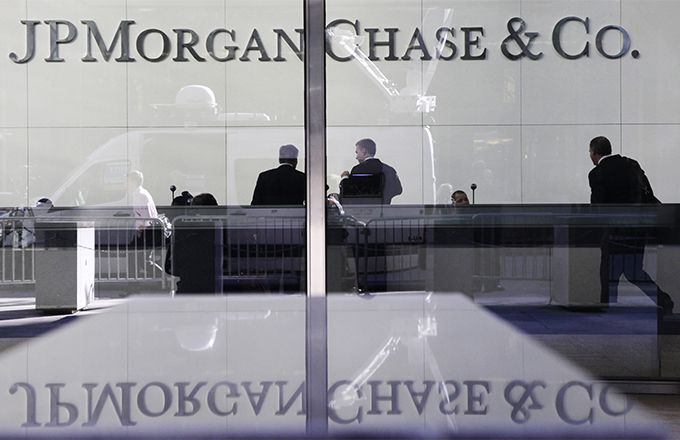[ad_1]
Major Moves
Earnings season kicked off today with announcements from two key financial institutions – JPMorgan Chase & Co. (JPM) and Wells Fargo & Company (WFC) – and the reactions couldn’t have been any different.
JPMorgan stock gapped higher at the opening bell – opening at its highest level in 2019 – and continued to climb higher throughout the day, closing at $111.21. Wells Fargo shares, on the other hand, tried to climb higher in early trading but ended up sliding below key support at $47.50 to close the day at $46.49.
So what was the difference? Both companies beat their earnings expectations – with JPMorgan beating the consensus estimate of $2.35 by $0.30 per share and Wells Fargo beating the consensus estimate of $1.10 by $0.10 per share. However, earnings are backward-looking numbers. While these numbers are important, investors tend to care more about what the company is going to do in the future than what it has done in the past.
That’s why Wells Fargo CFO John Shrewsberry’s downgraded guidance for the bank’s net interest income moving forward was so disappointing. Investors had expected the bank to forecast net interest income somewhere between a contraction of 2% and growth of 2% for 2019. Instead, Shrewsberry said the bank expects a contraction of somewhere between 2% and 5%. It appears a flattening yield curve and rising deposit rates – driven by banks competing with each other to attract new customers – are primarily to blame for the anticipated contraction.
Investors reacted to this news of an anticipated contraction by selling shares of Wells Fargo. JPMorgan, on the other hand, was able to attract new investors on the strength of its consumer and community banking numbers and a rebound in its investment bank profits. The surge in JPMorgan buying took the stock back up to the $112 resistance level it had previously established in November and early December 2018 before the bear market pullback at the end of the year.
Even though Wells Fargo was unable to climb higher today, JPMorgan’s strength is a good sign for the rest of the major banks in the financial sector that are going to be reporting earnings next week. If they report similarly strong numbers, the S&P 500 may have a chance to challenge its all-time high this earnings season.
S&P 500
The S&P 500 established a new high for 2019 by climbing to 2,910.54 in early trading, but it didn’t do much after that, pulling back slightly to a close price of 2,907.41. While not a huge move to the upside, the fact that the index has been resilient enough to continue climbing slowly higher is a positive sign that traders are still cautiously adding to the equity portion of their portfolios.
However, it wasn’t all roses on Wall Street today. The health care sector continued its decline as Anthem, Inc. (ANTM) plunged 8.48% and UnitedHealth Group Incorporated (UNH) dropped 5.18% – part of its biggest two-day sell-off in 10 years – today in the wake of Bernie Sanders’ announcement of his “Medicare for All” plan.
Netflix, Inc.’s (NFLX) stock also dropped 4.49% on The Walt Disney Company’s (DIS) announcement it is going to launch Disney+, its own streaming video service, at a price of only $6.99 per month. This could be a huge threat for Netflix, which has been consistently raising the price of its monthly service.
Risk Indicators – VIX
The CBOE Volatility Index (VIX) confirmed the bullish sentiment that seems to be permeating Wall Street these days as it closed right at its low for the day: 12.0. This is an excellent sign that, even though investors are still being somewhat cautious as they add to their bullish stock positions, they are not being cautious when it comes to insuring their portfolios with protective put options on the S&P 500.
Typically, investors buy more put options – which increase in value when the underlying asset experiences a price decline – on the S&P 500 when they are nervous that the index is going to drop in the future. They do so hoping that the increase in the value of the puts will offset some of the losses they might experience in their equity holdings.
This increase in demand for the put options pushes both the price of and the implied volatility levels for the puts higher. This results in the VIX – an implied volatility index based on S&P 500 put and call options – to move higher as well.
Conversely, when investors aren’t concerned about the S&P 500 moving lower, they tend to buy fewer put options on the index. This decrease in demand usually pushes both the price of and the implied volatility levels for the puts lower. As a result, the VIX also moves lower.
Seeing the VIX close at its lowest level since Oct. 3, 2018, is an encouraging sign that investors believe this could be a bullish earnings season for the U.S. stock market.
Bottom Line – Only the Opening Salvo
While it may be tempting to think today’s price action on Wall Street guarantees us a great earnings season, it’s far too early to make that claim. Today’s bullish earnings numbers from JPMorgan and Wells Fargo were just the opening salvo in a months-long process. Watch for more volatility ahead.
Enjoy this article? Get more by signing up for the Chart Advisor newsletter.
[ad_2]
Source link Google News

